The Stream, February 22, 2023: Rising Floodwaters in Kentucky and West Virginia Prompt State of Emergency

Flood gates in eastern Kentucky. Brett Walton / Circle of Blue
YOUR GLOBAL RUNDOWN
- An underground nuclear test site in North Korea may have exposed tens of thousands of people to groundwater containing radioactive material.
- First Nations in Manitoba are using Traditional Knowledge to re-imagine flood mapping, management, and preparedness.
- In rural Sudan, women-led conservation projects are creating solutions in the face of desertification and looming water shortages.
- Rising floodwaters in Kentucky and West Virginia are compounded by mining, poor infrastructure, and environmental racism, activists say.
Near waterways in the Ecuadorian Amazon, Indigenous resistance to mining activity is made difficult by poor regulation and widespread corruption.
“I thought I would always be able to drink from this river. Now I’m at this point where maybe I shouldn’t even swim in the water. That is really heartbreaking for me.” – Eli Virkina, a member of an Indigenous Kichwa community in Napo, Ecuador.
Al Jazeera reports that near the Andean foothills in northeastern Ecuador, where the Amazon rainforest and many rivers stretch, mining activity has exposed Indigenous communities to concentrations of toxic metals up to 352 times the advisable level. Those living along the Anzu, Jatunyacu, and Napo rivers have elevated cancer risks; and relying on river water for food, water, and cultural practice poses great threats to their health, community members say. Per Al Jazeera, the toxifying environment is weighing heavily on some peoples’ mental health.
One year ago, the Ecuadorian government ruled that Indigenous communities would have “a final say” over mining projects on their ancestral homelands — but this law has often been skirted, Al Jazeera reports, as flimsy governance, corruption, and bribes have left the tribes to resist mining activity, and defend their homes, themselves.
— Christian Thorsberg, Interim Stream Editor
Recent WaterNews from Circle of Blue
- Ongoing Battle to Keep Toxic Chemicals at Bay — A growing array of contaminants threaten Michigan’s rivers, lakes and drinking water systems, and many of them are still unregulated.
- Flush with Cash, State Lawmakers Consider Water Risks — Water is poised for prominence this year in state law and policy.
The Lead
Just eight months after last summer’s devastating flooding, heavy rains are once again battering eastern Kentucky and areas of West Virginia, causing flood waters to rise and claiming at least two lives in the past week. Jim Justice, the governor of West Virginia, declared a state of emergency in response to the floods, and Grist reports accounts of rescues, stranded cars, and road closures in the region, which last July experienced floods that “led to the deaths of dozens of residents, and damaged thousands of homes.”
The American Southeast, due to climate change, is expected to experience extreme weather events more often in the near future. According to the Fourth National Climate Assessment, the American Southeast, by 2100, under a high-pollution scenario, may experience double the number of heavy rainfall events as today. “Flooding events here have lost their seasonality,” Yale Climate Connections reports.
Aging drainage infrastructure and poor floodwater buffers present additional challenges for people living in the region, especially in rural areas. Black and brown communities are especially vulnerable — according to Yale, while flood damage will increase by 25 percent in the next 30 years, “communities that have a disproportionate number of Black people, they will see a 40 percent increase.”
And exacerbating the effects of flooding, most of all, in Kentucky, is the state’s strip mining legacy. The mines, which tend to operate at headwaters and clear high-elevation land of trees and topsoil, makes rushing waters all the more dangerous, both Grist and Yale report. The two outlets also report on the proof of these effects: Kentuckians for the Commonwealth, a social justice organization, gathered evidence that, they say, verifies 36 of last summer’s 43 deaths occurred downstream from large-scale strip mines.
This Week’s Top Water Stories, Told In Numbers
90
Percent of Manitoba First Nations estimated to have been affected by seasonal flooding, The Narwhal reports. But despite these overwhelming numbers, and tribes’ knowledge in detecting impending floods, those seeking federal funding to protect against such events are subject to government forecasts — which historically have been conservative or off the mark, per The Narwhal. The discrepancies often cost First Nations the resources they need to protect their homes; last spring, for example, a devastating flood, for which funding was denied based on an incorrect governmental assessment, cost the Peguis First Nation $300 million in repairs. Working toward a solution, representatives from 34 Manitoba First Nations met last week to “re-imagine flood maps with an emphasis on Traditional Knowledge and local community input.” Tribes are pushing for community-first flood preparedness infrastructure and policies, and creating flood models that are more accurate than those that insurance companies publish.
1.5
Kilometers per year (0.93 miles) that the Sahara Desert moves southward into Sudan, where this desertification is compounded by political instability, development, and climate change as a water crisis looms. Farmers and pastoralists in the country’s north are especially vulnerable to this lack of water and rising temperatures, the United Nations reports. But women-led community projects, including harvesting drought-resistant crops, building a reservoir, and restoring rangeland for native species, in partnership with the UN, have helped create climate-adaptive villages and farmland.
On the Radar
A new report from the Transitional Justice Working Group, a human rights group based in Seoul, reveals that tens of thousands of North Koreans may be exposed to radioactive materials, the result of an underground nuclear testing site tainting groundwater reserves. Reuters reports that six nuclear weapons tests occurred in the mountainous North Hamgyong Province between 2006 and 2017. Per the report, more than one million people live in the site’s surrounding regions. And the exposure may cross borders — those in South Korea, China, and Japan may also be at risk, as crop and fish smuggling from the potentially contaminated area has been well-documented.
More Water News
Mangrove Conservation: Mongabay reports on a new study that maps priority conservation areas in West Bengal, India, where “the world’s largest single block of mangrove” is rapidly disappearing.
Financial Sector: Following the COP15 Biodiversity Conference, Thérèse Coffey, the United Kingdom’s environment secretary, has called on the world’s private and financial sectors to do more in achieving global climate goals — including scaling global funding to $200 billion per year by 2030, The Guardian reports.
Christian Thorsberg is an environmental writer from Chicago. He is passionate about climate and cultural phenomena that often appear slow or invisible, and he examines these themes in his journalism, poetry, and fiction.






Leave a Reply
Want to join the discussion?Feel free to contribute!